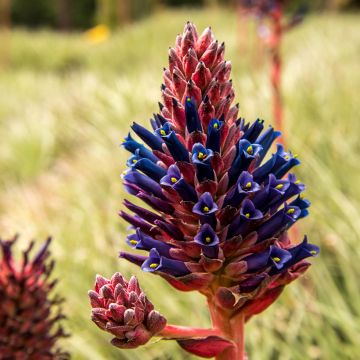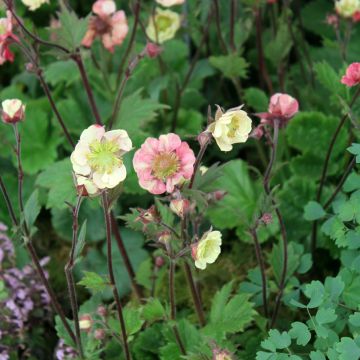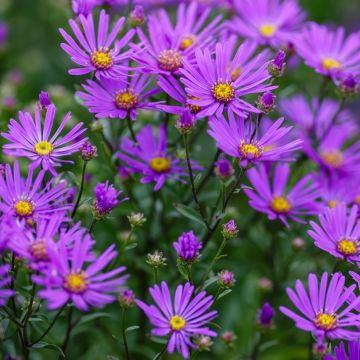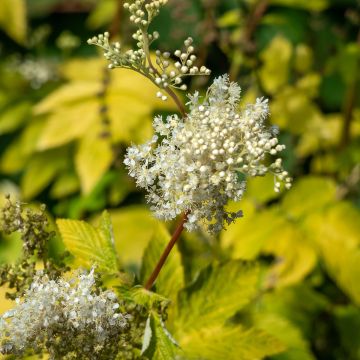

Puya berteroniana


Puya berteroniana


Puya berteroniana


Puya berteroniana


Puya berteroniana


Puya berteroniana


Puya berteroniana


Puya berteroniana


Puya berteroniana
Puya berteroniana
Puya berteroniana
Bertero's Puya
Fantastic plant, larger than I expected, delivered very quickly. I am delighted.
Sophie, 10/02/2024
Special offer!
Receive a €20 voucher for any order over €90 (excluding delivery costs, credit notes, and plastic-free options)!
1- Add your favorite plants to your cart.
2- Once you have reached €90, confirm your order (you can even choose the delivery date!).
3- As soon as your order is shipped, you will receive an email containing your voucher code, valid for 3 months (90 days).
Your voucher is unique and can only be used once, for any order with a minimum value of €20, excluding delivery costs.
Can be combined with other current offers, non-divisible and non-refundable.
Why not try an alternative variety in stock?
View all →This plant carries a 12 months recovery warranty
More information
We guarantee the quality of our plants for a full growing cycle, and will replace at our expense any plant that fails to recover under normal climatic and planting conditions.
Would this plant suit my garden?
Set up your Plantfit profile →
Description
The Puya berteroniana is a remarkable Chilean perennial that will delight botanical enthusiasts. This Chilean cousin of the pineapple offers one of the most spectacular flowerings in the plant world. While it takes time and only appears on plants at least 6 years old, its flower spike is stunning: massive, reaching heights of up to 4 m (13ft), it bears countless tulip-like flowers that appear to be from another world. Woven from turquoise blue satin with metallic reflections, punctuated with orange stamens, they are filled with nectar that birds adore. This flowering often marks the death of the rosette that carries it, but the plant ensures its survival through daughter rosettes and spontaneous seedlings that germinate under favorable conditions. Still rare, this exotic puya, which is not as tender as it seems, is starting to make its appearance in our gardens with mild climates. To showcase it, give it a large, well-drained rockery and a sunny or partially shaded exposure in our warm and dry regions.
The Puya berteroniana belongs to the bromeliad family. It is native to the Valparaiso and Santiago regions of Chile, dominated by a Mediterranean climate with dry summers and relatively mild and humid winters. It is found on the northern slopes of the Andean foothills, covered by scrub vegetation called matorral: in the Southern Hemisphere, north-facing slopes receive the most sunlight. This high-altitude botanical species (1200-2300 m (3937-7546ft)) can tolerate short freezes of around -7/-8°C in well-drained soil. It grows in poor, rocky, dry, basaltic (alkaline) soils. Its foliage persists throughout the year.
The plant develops slowly, forming a rosette of basal leaves that spreads horizontally and produces shoots late in life. The leaves, which can reach up to 1 m (3ft) in length, form a fountain-like clump, eventually occupying a space of 2 m (7ft) in all directions. They curve towards the ground, are very narrow, leathery, pointed, covered in a wax-like coating, and bordered by formidable spikes in the shape of hooks. Their colour, greener in winter, takes on silvery reflections in summer due to heat and drought. Flowering usually occurs in late spring in our latitudes, in May-June. From the centre of the mature rosette, a green almond-shaped flower spike emerges, covered in flower buds. The first flowers open on the main stem, which then branches into sterile secondary stems on which birds perch. The flowers, with three fleshy and glossy petals, iridescent turquoise blue in colour, form deep cups, and are numerous and tightly packed together. Each flower measures 3 to 4 cm (1 to 2in) in diameter and has three stamens covered in orange pollen. They are filled with a syrupy blue nectar that birds and large pollinating insects delight in. After pollination, the plant produces a large quantity of seeds, of which only a few will germinate. If the flower spike is removed before seed formation, the rosette may not perish. The Puya berteroniana usually persists through the development of daughter rosettes that emerge near the base.
This fabulous Puya berteroniana is a collector's plant that deserves a prime spot in our gardens with mild climates. It can be placed in a large exotic rockery, for example, alongside Yucca, modest palms, Phormium, or hardy tall cacti such as Echinopsis, Cereus strausii or aethiops for example. The light shade of certain trees does not prevent it from flowering in warm regions. It can be cultivated without difficulty on a terrace, where it will reign in a large pot filled with sand and compost, to be stored (handling it with caution as it is very "hooked") in a greenhouse or conservatory to protect it from severe frosts. It is undoubtedly one of the most extraordinary species of Puya: its cultivation in open ground is definitely worth trying in mild regions. According to our own experience, it seems to tolerate slightly alkaline (but light) soils well and withstands summer drought.
Puya berteroniana in pictures






Flowering
Foliage
Plant habit
Botanical data
Puya
berteroniana
Bromeliaceae
Bertero's Puya
South America
Other Puya
View all →Planting and care
The Puya berteroniana is preferably planted in spring. Choose a sunny or partially shaded location in the afternoon in very hot regions. Install it in a perfectly drained soil, enriched with pumice, potting soil, and gravel. It will be hardy up to -7/-8°C (19.4/17.6°F) if the soil is almost dry in winter. In summer, it fears the combination of heat and excessive soil moisture, which causes its roots to rot. Once established, this Puya generally does not require watering in summer. In very dry regions, occasional watering will be welcome, as well as a foliage shower at the end of a hot day. It is quite accommodating regarding the soil's pH, which can be acidic, neutral, or slightly alkaline.
Pot cultivation: prepare a large container with a perforated bottom that you will fill with a mixture of potting soil, sand, and pumice. Water regularly, without exaggeration. Add a little cactus or succulent fertiliser to the watering water in spring.
Planting period
Intended location
Care
Planting & care advice
-
, onOrder confirmed
Reply from on Promesse de fleurs
Similar products
Haven't found what you were looking for?
Hardiness is the lowest winter temperature a plant can endure without suffering serious damage or even dying. However, hardiness is affected by location (a sheltered area, such as a patio), protection (winter cover) and soil type (hardiness is improved by well-drained soil).

Photo Sharing Terms & Conditions
In order to encourage gardeners to interact and share their experiences, Promesse de fleurs offers various media enabling content to be uploaded onto its Site - in particular via the ‘Photo sharing’ module.
The User agrees to refrain from:
- Posting any content that is illegal, prejudicial, insulting, racist, inciteful to hatred, revisionist, contrary to public decency, that infringes on privacy or on the privacy rights of third parties, in particular the publicity rights of persons and goods, intellectual property rights, or the right to privacy.
- Submitting content on behalf of a third party;
- Impersonate the identity of a third party and/or publish any personal information about a third party;
In general, the User undertakes to refrain from any unethical behaviour.
All Content (in particular text, comments, files, images, photos, videos, creative works, etc.), which may be subject to property or intellectual property rights, image or other private rights, shall remain the property of the User, subject to the limited rights granted by the terms of the licence granted by Promesse de fleurs as stated below. Users are at liberty to publish or not to publish such Content on the Site, notably via the ‘Photo Sharing’ facility, and accept that this Content shall be made public and freely accessible, notably on the Internet.
Users further acknowledge, undertake to have ,and guarantee that they hold all necessary rights and permissions to publish such material on the Site, in particular with regard to the legislation in force pertaining to any privacy, property, intellectual property, image, or contractual rights, or rights of any other nature. By publishing such Content on the Site, Users acknowledge accepting full liability as publishers of the Content within the meaning of the law, and grant Promesse de fleurs, free of charge, an inclusive, worldwide licence for the said Content for the entire duration of its publication, including all reproduction, representation, up/downloading, displaying, performing, transmission, and storage rights.
Users also grant permission for their name to be linked to the Content and accept that this link may not always be made available.
By engaging in posting material, Users consent to their Content becoming automatically accessible on the Internet, in particular on other sites and/or blogs and/or web pages of the Promesse de fleurs site, including in particular social pages and the Promesse de fleurs catalogue.
Users may secure the removal of entrusted content free of charge by issuing a simple request via our contact form.
The flowering period indicated on our website applies to countries and regions located in USDA zone 8 (France, the United Kingdom, Ireland, the Netherlands, etc.)
It will vary according to where you live:
- In zones 9 to 10 (Italy, Spain, Greece, etc.), flowering will occur about 2 to 4 weeks earlier.
- In zones 6 to 7 (Germany, Poland, Slovenia, and lower mountainous regions), flowering will be delayed by 2 to 3 weeks.
- In zone 5 (Central Europe, Scandinavia), blooming will be delayed by 3 to 5 weeks.
In temperate climates, pruning of spring-flowering shrubs (forsythia, spireas, etc.) should be done just after flowering.
Pruning of summer-flowering shrubs (Indian Lilac, Perovskia, etc.) can be done in winter or spring.
In cold regions as well as with frost-sensitive plants, avoid pruning too early when severe frosts may still occur.
The planting period indicated on our website applies to countries and regions located in USDA zone 8 (France, United Kingdom, Ireland, Netherlands).
It will vary according to where you live:
- In Mediterranean zones (Marseille, Madrid, Milan, etc.), autumn and winter are the best planting periods.
- In continental zones (Strasbourg, Munich, Vienna, etc.), delay planting by 2 to 3 weeks in spring and bring it forward by 2 to 4 weeks in autumn.
- In mountainous regions (the Alps, Pyrenees, Carpathians, etc.), it is best to plant in late spring (May-June) or late summer (August-September).
The harvesting period indicated on our website applies to countries and regions in USDA zone 8 (France, England, Ireland, the Netherlands).
In colder areas (Scandinavia, Poland, Austria...) fruit and vegetable harvests are likely to be delayed by 3-4 weeks.
In warmer areas (Italy, Spain, Greece, etc.), harvesting will probably take place earlier, depending on weather conditions.
The sowing periods indicated on our website apply to countries and regions within USDA Zone 8 (France, UK, Ireland, Netherlands).
In colder areas (Scandinavia, Poland, Austria...), delay any outdoor sowing by 3-4 weeks, or sow under glass.
In warmer climes (Italy, Spain, Greece, etc.), bring outdoor sowing forward by a few weeks.























































